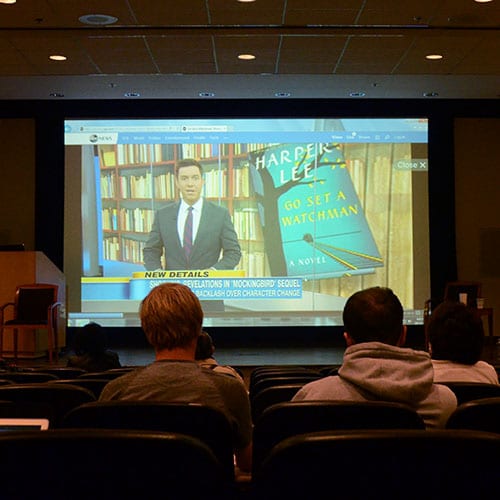
On Thursday, Oct. 15, faculty, students and staff gathered in Viking Theater to listen to the discussion panel “Who is Atticus Finch?” The panel addresed themes in Harper Lee’s new book, “Go Set a Watchman”, the sequel to her famous “To Kill a Mockingbird.” Weeks prior to the discussion, 20 free copies of “Go Set a Watchman” were given to members of the St. Olaf community. The event was hosted by the Race and Ethnic Studies, Africa and the Americas and History departments, and led by Associate Professor of English Joan Hepburn, Professor of English Mary Titus and History Professor Michael Fitzgerald.
The discussion opened with a video that provided the audience with some background information on the book. The panel concentrated on how the portrayal of protagonist Atticus Finch changes drastically between books.
Professor Titus began the discussion by questioning the novel’s literary merit and doubting whether it is actually Harper Lee’s work. To support her claim, she gave examples of instances that aroused suspicion surrounding the book’s publication. For one, Harper Lee is currently blind, deaf and living in a nursing home and had not published a single book since “To Kill a Mockingbird” in 1960. Additionally, she recently signed over the rights to “To Kill a Mockingbird,” raising uncertainty about whether the author is mentally capable of making particular decisions. Thirdly, Titus raised questions about how “Go Set a Watchman” came to be. It was rumored to be the original draft of “To Kill a Mockingbird,” not a stand-alone book. Titus also emphasized the Southern features of the novel and how it fits in with the work of many other Southern women writers.
“It definitely evokes the South’s small town in that lyric that we love in literature of the South,” Professor Titus said. However, she described the second half of the novel as “boring and unpleasant because of the long arguments and sporadic moments of action.” Titus concluded that “Go Set a Watchman” “taints more than Atticus, because it also taints ‘To Kill a Mockingbird’.”
Professor Fitzgerald then gave his historical perspective. He started by refuting the public notion that the characterization of Atticus in the sequel is inconsistent with his characterization in the prequel. He said that age might be a factor in the change of Atticus’s attitudes.
“People can be liberal in their 40s and be reactionary when they are 70, that’s not that big a stretch,” Fitzgerald said. He proceeded to identify contextual differences between the 1930s and 1950s:
“In the ’30s when the first novel occurs, you don’t have to work hard to be a relative liberal, but that is not pro-civil rights, it’s just a ‘black people have some rights’ stand, and in 1935 that makes Atticus a hero.” But in the 1950s, “Atticus is a moderate segregationist and [that means] he is like the rest of the white South, scared to death of what the emergence of the civil movement means.”
Professor Joan Hepburn then took her turn and described the book as “the South with a vengeance.” She claimed that the rich social themes within the book and its relationship to “To Kill a Mockingbird” are reasons that makes the book worth reading in spite of the diatribe style of writing.
Professor Hepburn also values “the critical questions the book raises about what it means to journey home, and what one faces as an adult that one might not have absorbed or articulated as a youth.” She explains the plot of the book as “what Jean Louise comes to see and at what cost. And not just to herself but to her definition of her family, of the society from which she comes, of the values she thought she held, of the icon that her father represented to her.” Professor Hepburn concludes that the novel is a bestseller “because it asks us how is it that we see the things that are real around us. Do we see them if they don’t affect us? Can we acknowledge where we are privileged, where we are blind and where we are victimized?”
The discussion moved to the screenplay adaptation of “To Kill a Mockingbird.”
“The movie and the book fit so well with the civil rights agenda making the issue not race as justice. The movie was politically important because it persuaded America that there were good whites out there,” Fitzgerald said.
Titus mentioned America’s infatuation with the movie because of its portrayal of “white innocence,” which was later destroyed by the sequel. Hepburn characterized “Go Set a Watchman” as the “smashing of the romantic view of whiteness in the South.”

